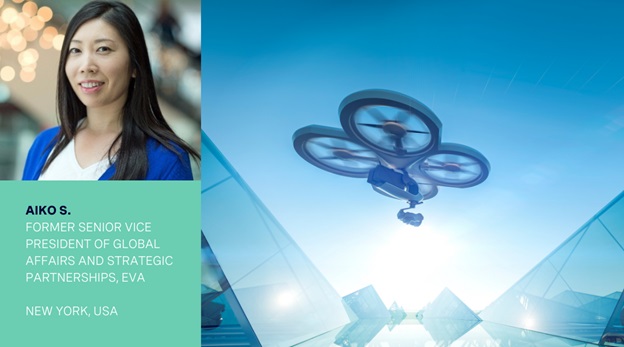What are the top risks and challenges, as well as the most untapped potential, relating to drone technology?
Aiko S.
Public Policy, Government and Philanthropy, Twitter / Former Senior Vice President of Global Affairs and Strategic Partnerships, Electric Visionary Aircrafts (EVA)
New York, USA
“Especially because the drone industry is still relatively new, there are many challenges and opportunities in this space. First, there are legal and regulatory hurdles that would need to be overcome for the technology to take off, such as privacy issues and safety standards. Second, as with other emerging technologies like autonomous driving, drones are creating new challenges and disrupting industries that have been in existence for a long time like the insurance industry. These stakeholders will have to work together to resolve difficult and contentious issues such as questions over liability and property damage. Third, drone technology itself still has the potential to improve, such as by increasing battery life and by incorporating technologies like renewable energy and even hydrogen to power drones.
Additionally, just as EVs require EV-charging infrastructure and not just the vehicles themselves, drones require infrastructure for takeoff, landing, and charging. Today, there is an investment of approx. 3 billion USD in the drone industry, but less than 1% of this has gone into drone infrastructure. I would like to see both public and private sectors do more on the investment and development of drone infrastructure. There is also a lot of potential for drone infrastructure solutions to incorporate future trends in sustainability and connectivity, such as drone infrastructure that incorporates 5G network coverage and utilizes clean energy while still ensuring high safety standards, energy efficiency and low operational costs.
Lastly, drones have the potential to provide solutions to many global challenges such as improving the delivery of critical supplies like water, food, medicine, humanitarian aid, disaster response, surveillance & inspection, services, and agricultural output. In this sense, drones can play an important role in contributing to the 17 UN Sustainable Development Goals – even ones that seem less relevant to drones like SDG 5: Gender Equality. For example, in many rural parts of developing countries, women are often the providers of food and water and the ILO estimates that a lack of transportation infrastructure lowers their participation in the labor force by 16.5% as they may have to travel longer distances to obtain critical supplies for their families. Technologies like drones may contribute to closing the gender gap in employment through improving access to critical supplies and allowing more women to participate in the economy.”

